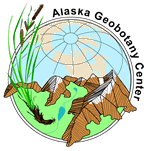Alaska Arctic Detailed Plant Community Description
- AATVM
- Vegetation
- Bioclimate Subzones
- Floristic Provinces
- AVHRR
- Elevation
- Lake Cover
- Physiography
- NDVI and Phytomass
- Substrate Chemistry
- Literature
Naming convention for the plant communities
Each numeric community code appearing on the AATVM has a web page that provides more detailed information.
The numeric codes correspond to the 85 community codes on the back side of the AATVM. Each code has a community name (not necessarily unique for each code as explained below). The naming convention roughly follows the US National Vegetation Classification Standards for units at the Association level (Federal Geographic Data Committee 2008). Each community name consists of two Latin species names separated by a hyphen. The first name is the dominant or most common species, and the second is a co-dominant or characteristic species. For example, all the plant communities occurring on dry gravelly nonacidic substrates dominated by Dryas integrifolia with the sedge Carex rupestris are given the name Dryas integrifolia-Carex rupestris.
Many of the unit names also include a subtype designated by a plant species that is characteristic of a given floristic subprovince or bioclimate subzone or substrate. For example, the cushion forb Oxytropis nigrescens is often found in extreme Dryas-Carex communities of the Northern Alaska floristic subprovince, so these communities are given the name Dryas integrifolia-Carex rupestris subtype Oxytropis nigrescens. In much of western Alaska particularly on the Seward Peninsula the Dryas communities on limestones often have the conspicuous dwarf shrub Rhododendron camtschaticum, so these communities are called Dryas integrifolia-Carex rupestris subtype Rhododendron camtschaticum.
Organization of the plant-communities in tabular format
Table 1 contains a summary of the community names organized hierarchically by bioclimate subzone, floristic subprovince, substrate and toposequence position (this is a condensed version of the table that appears on the back side of the AATVM). There are not unique plant-community names for each numeric code because many of the plant communities have distributions that cross bioclimate, floristic, or substrate boundaries. The names should be considered tentative because in some cases they are based on scant field data, and none of the names have been currently described and accepted according to the formal FGDC protocols (Jennings et al. 2009).
Table 1: Plant Community Names
Description
The description of each community contains:
- Bioclimate subzone: Three subzones occur in Alaska: C, D, and E.
- Floristic province: Three subprovinces of the Beringian group of provinces occur in Alaska: Northern Alaska, Beringia Alaska, Northern Beringian Islands.
- Substrate chemistry: Acidic, circumneutral, carbonate, and saline. (Note: Only the acidic and nonacidic categories appear in the table on the back side of the map.)
- Position along the topographic gradient (toposequence): Dry exposed sites, mesic (including zonal) sites, wet sites, snow-bed sites (sometimes subdivided into early-melting and late-melting snowbeds), and riparian sites (sometimes subdivided into stabilized and active floodplains).
- Summary of habitat: A brief statement that describes the primary habitat for the community.
- Described from: Geographic location and literature source of from which the community and habitat information comes.
- Common plant functional types and species: The common plant functional types (PFTs) are listed in order of their relative importance. Within each PFT category the first one or two are generally the most abundant and the others are listed alphabetically.
- General comments: A short paragraph gives more details regarding the habitat and a general description of the plant community.
- Braun-Blanquet names for plant communities that fit into B-B units that have been described for Alaska. For example, the Dryas community described above is referred to in the Braun-Blanquet approach by the name Association Carici-Dryadetum integrifoliae (Daniëls 1982) that has been described in Greenland and other parts of the Arctic.


